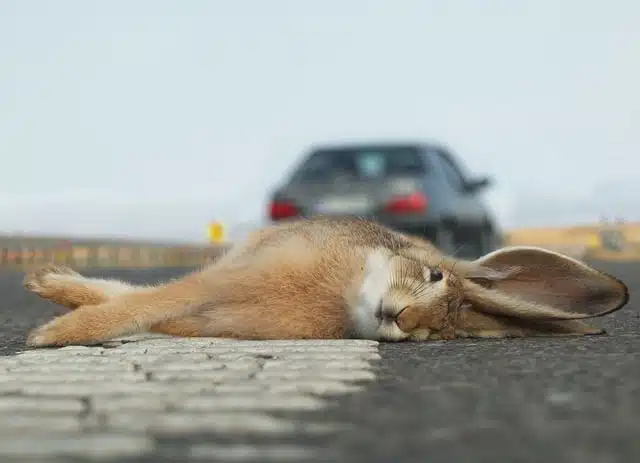Home » Blog » Pet » Pet Health & Safety » What to Do If You Hit an Animal While Driving in Australia
Categories
Tags
animal welfare
breed profile
buying a car
buying a pet
Car
car accessories
car care
car features
car insurance
Car safety
car sales
car service
cat
cat behaviour
cat body language
Cat Breeds
cat food
cat insurance
comprehensive car insurance
Dog
Dog Behaviour
dog body language
Dog Breeds
dog food
Dog Insurance
dog training
eco friendly cars
Kitten
New Car
pet accessories
pet activities
Pet Adoption
pet breeders
pet days of the year
pet fun stuff
Pet Health
pet insurance
pet parenting
Pet Safety
pet services
Puppy
rescue pets
road safety
road trip
safe driving
Recent Blog:
Facebook Posts
1 day ago
Growing old sometimes means we can’t take care of pets anymore. Find out some advice on what to do when this happens:![]()
![]() Senior Pet Parents – Contingency Plans for Your Pet – bit.ly/44bzwkS
... See MoreSee Less
Senior Pet Parents – Contingency Plans for Your Pet – bit.ly/44bzwkS
... See MoreSee Less
Senior Pet Parents' Contingency Plans for Pets
www.pd.com.au
Sometimes senior pet parents need more downtime. For older pet owners, this can be tricky to navigate if their dog or cat is full of beans and wants to3 days ago
Before you rev up the engine, let’s run through a checklist of things to do before starting your car. Not only do these steps ensure your safety (and that of others around you), but they also help in maintaining your vehicle's longevity.![]()
![]() Driving Tips: Your Checklist Before Starting Your Car -
... See MoreSee Less
Driving Tips: Your Checklist Before Starting Your Car -
... See MoreSee Less
Driving Tips: Your Checklist Before Starting Your Car
www.pd.com.au
Heading out for a drive? Hold up a second! Whether you're dashing off to work, running errands, or embarking on a road trip adventure, there are a few1 week ago
Are intestinal worms setting up camp in your dog’s gut without paying rent? Here’s how to spot the main culprits and get rid of them too:![]()
![]() Preventing, Identifying and Treating Intestinal Worms in Dogs - bit.ly/43YjCKu
... See MoreSee Less
Preventing, Identifying and Treating Intestinal Worms in Dogs - bit.ly/43YjCKu
... See MoreSee Less
Preventing, Identifying and Treating Intestinal Worms in Dogs
www.pd.com.au
Intestinal worms, such as roundworms in dogs are one of the least glamorous topics on the planet. These intestinal parasites that basically use our dogsIf you’ve hit an animal while driving then you’ll know it’s a horrible feeling. No matter what time of day you’re driving there are plenty of animals on the road or close to it, making roadkill a sad but real possibility. The number of kangaroos in Australia alone is double that of humans. Just add the 20 million or so cars driving around and it’s a recipe for animal related car accidents.
Thankfully, there are several preventative measures you can take to avoid car accidents with animals. There are also specific steps to take if you do end up colliding with an animal on the road, leading to injury or roadkill.
In this article we share top tips to cover this territory, keeping you, your passengers and the animals you share the road with as safe as possible.
In this article
- Why are animals on the road in the first place?
- How to avoid hitting animals on the road
- What animals are on the road in Australia?
- Steps to take if you hit an animal on the road
- Where to take an animal hit by car and who to call
- Do I need to report a dead or injured hit animal?
- Emergency car supplies in case you hit an animal
- Does car insurance cover if you’ve hit an animal?
Why are animals on the road in the first place?
It doesn’t take rocket science to see that the number of humans and cars, with our ever-encroaching suburban sprawl and the infrastructure that comes with this, all have a significant impact on native wildlife. This impact often extends to farm animals too. Last but not least, our pets sometimes go walk-a-bout…
As valued members of more households than not, the likelihood of an animal car accident involving pets is a real concern:
PD Insurance research shows that of all the hazards local pet owners are concerned about, ‘getting run over by a vehicle’ ranks number one.
Besides habitat encroachment, pets can go wandering when they’re looking for a mate and when they bolt in fright. Understanding threats to pet safety like fireworks is all about preventing your cat or dog from running off. A neutered or spayed dog or cat is also less likely to be found wandering the roads.
As pet parents, the best we can do for our cats and dogs’ safety is keep them contained at home when we’re not around and on a leash during walks. Learn how to walk your puppy on a lead then read the PD Guide to Dog Leashes and Leads. Since we’re cat lovers too, here’s how to start training your cat to walk on a leash.
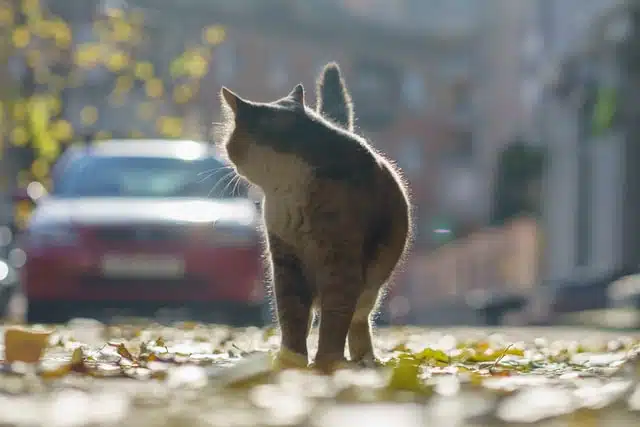
How to avoid hitting animals on the road
The best thing you can do to avoid hitting an animal on the road, or any type of road incident for that matter, is to practice defensive driving. That’s always the first step when you’re behind the wheel.
Over and above this, here’s what you should know about preventing roadkill:
- Dusk and dawn. Several species of Australian fauna are very active at dusk and dawn. When driving at this time of the day it’s best to slow down and be aware.
- Beep your horn. Even in built up urban areas, wombats and wallabies will gather on the sides of roads. If you see one, there’ll likely be many others. Beep your horn sharply to scare them off if you need to. Don’t get out to shoo away healthy, hefty animals.
- Don’t swerve into oncoming traffic. Never do this as you could avoid hitting an animal only to cause a road accident with other drivers.
- Follow the signs. Importantly, pay attention to road signs signalling areas with high wildlife populations and crossings and report livestock on roads to the police.
- Regional vs metro. Don’t let your guard down and speed up on open regional roads. This is a common occurrence that results in high numbers of accidents of all kinds. Not just animal related accidents.
Be sure to read about regional vs metro driving habits and statistics to see why you should never let your guard down even once you’re out of the hub-bub of city traffic. Roadkill is an awful experience that you may be able to avoid just by staying alert behind the wheel.
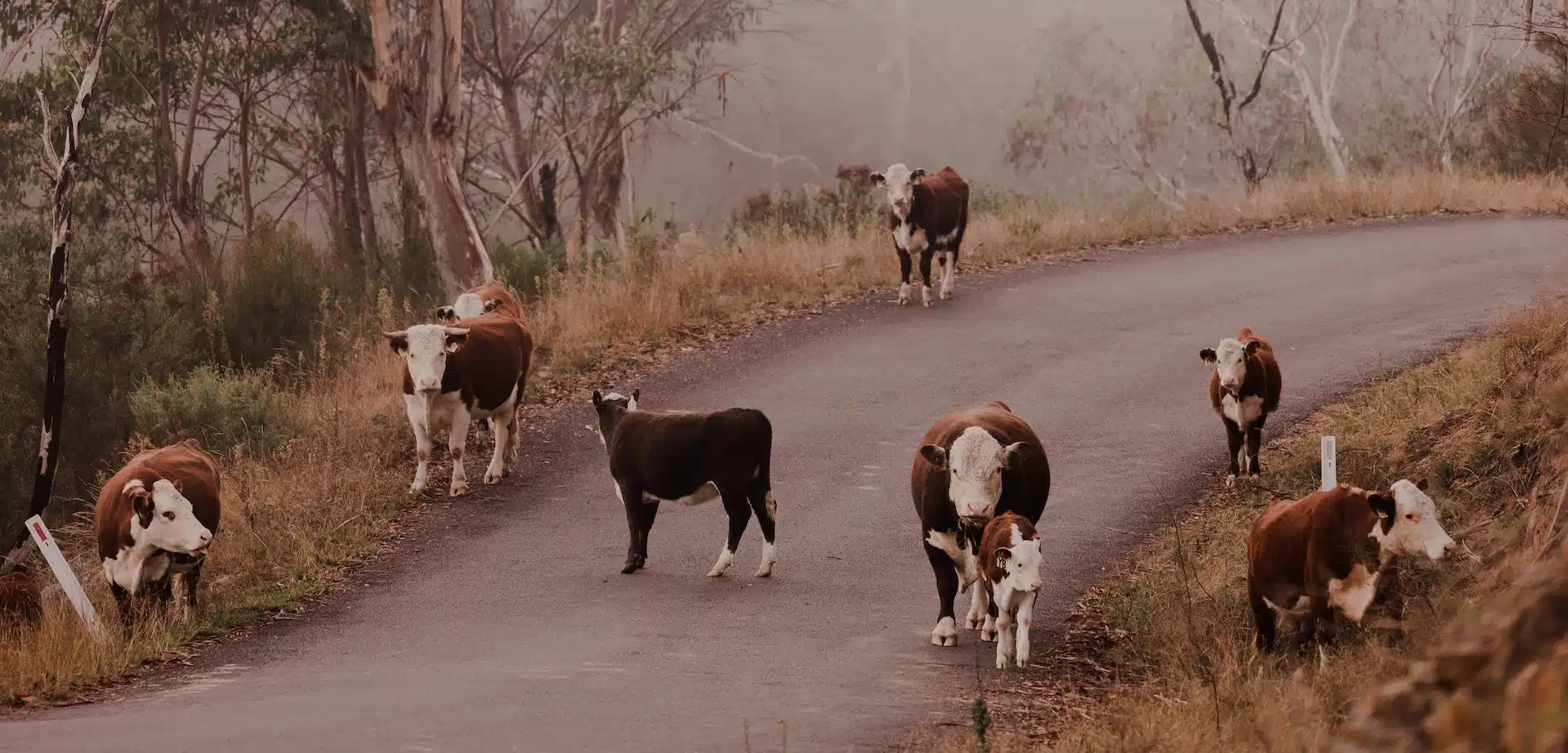
What animals are on the road in Australia?
As our country continues to develop, more and more wildlife habitats are lost to land clearing. Animals find themselves homeless as the pockets of forests and bush land they call home get smaller. There are many types of animals that you’re likely to find out on the road.
Here’s an overview of which furry, spiky and feathered friends you might encounter when you’re driving in Australia:
Wildlife
If wallabies, koalas, wombats, echidnas, etc, don’t have access to the right trees, food or water, they’ll travel to find them. This often means crossing roads and highways. As their habitats can be on the city fringes, this means higher speed limits and. well, we all know the outcome.
Then there’s the likes of coastal animals such as penguins, who come ashore at dusk, wander onto roads and are difficult for drivers to see due to their colouring.
Livestock
A significant number of car accidents in rural areas involve livestock or wildlife, and there are even more ‘near misses’ where a vehicle swerved to avoid them.
The vast majority hit are native animals. However, farm animals such as sheep, horses, cattle and goats are often found wandering on rural roads.
Pets
Sadly, many dogs and cats are hit in city and suburban areas every day. The increasing number of pets in Australia means an increased risk of an animal related car accident when you’re on the road.
It might be because they’ve escaped from their home, stepped out from the roadside at the wrong time or wandered off when their owner takes a break on a pet-friendly road trip. If it’s the latter, and your pet has bolted, then read about finding lost pets on holiday road trips.
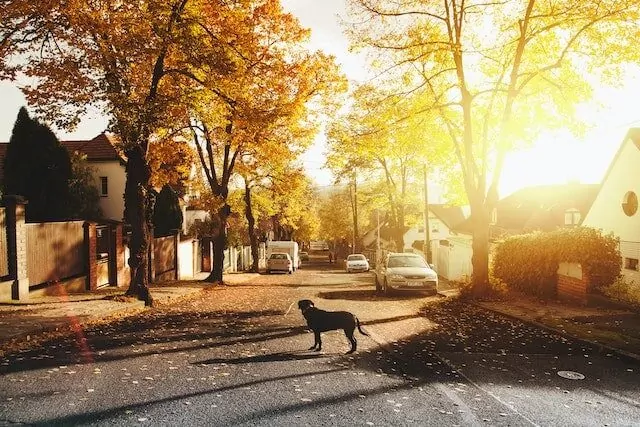
Steps to take if you hit an animal on the road
You’ll know if you hit an animal – there is a heart-stopping thud that quickly turns into a distressing realisation there may be roadkill.
#1 Safety first
If this happens you must only pull over if you’re sure it’s safe to do so. Your initial instinct might be to get out of the car immediately to tend to the injured animal. But before you do that, you need to check it’s safe to do so. There may be other cars hurtling towards you and you need to be sure there’s no risk of further incident.
Be careful of other traffic about; don’t risk your life.
Once you’ve checked and it’s all clear then pull over to the side of the road. Put your handbrake on and turn on your hazard lights – this helps other drivers see your stationary car from a distance.
Now it’s time to tend to the animal.
#2 Make it comfortable
If the animal is alive after a car accident then it’s going to be scared and very likely injured. You’ll need to assess how to safely help it. For example, how large or hostile is it? Big or small? Many animals can become aggressive when feeling threatened and in pain.
If you can do so without risking your own safety then approach the animal quietly and calmly from the front. This gives the animal a chance to see you so that it doesn’t lash out in surprise.
You’ll need to cover and keep it warm and quiet while you seek help, so handle it using a towel, blanket or clothing. This protects both you and them.
Make sure the bite-y and scratchy body parts are covered before carrying it to your car. An unconscious animal may wake up during the rescue mission and could end up causing further damage to you or your car interior (as well as themselves).
Or, you may choose to wait by the side of the road for an animal rescue group. Either way you will need to make it as comfortable and calm as possible. And be sure to wash your hands as soon as you can! Keeping liquid detergent in the car will help keep the germs at bay.

#3 When not to handle an injured animal
There may be times when moving an injured animal would put you at risk and cause further injury to the animal. If you’re unsure, the police, a vet or an animal rescue centre will be able to provide further advice following an animal related car accident.
Aside from bites and scratches, there’s also the potential you could pick up any number of diseases or develop a nasty infection. For example, never touch or handle any bats as they are likely to carry viruses that are harmful to humans.
If you do get bitten or scratched by the animal you’re trying to care for, flush the wound with water then follow basic first aid and watch for signs of infection.
From there, visit your GP as soon as you can. You may need antibiotics, a tetanus booster or some other kind of shot to guard against any nasties. Animal’s teeth and nails can carry nasty bacteria that can get into your blood and make you very sick and quickly.
#4 In case of roadkill
If the animal has been killed and it’s safe to do so then you have a responsibility to move it off the road. This will help prevent driving dangers for other vehicles. Roadkill also attracts scavengers that could be an added danger to traffic – all the more reason to safely remove the animal from the road.
Be extra cautious and gentle with mammals such as wallabies or wombats as they may have babies in their pouches that can still be saved. If they’re still safely tucked in their mother’s pouch they could still be suckling so don’t remove them from the pouch.
The babies may also be on the road or in nearby bushes if they’ve fallen out during the accident so take a careful look at the surrounding area. Keep them warm and contact a vet or rescue like WIRES for assistance.
Watch the PD Pet Care NZ vlog with Dr Cath Watson for more advice on steps to take if you’ve hit an animal:
Where to take an animal hit by car and who to call
If the animal is still alive or it has live babies then you could find the closest vet and take the animal there. You’ll find many vets will take in and treat injured native wildlife and domestic animals. It’s a good idea to call ahead as not all do, for example and not every vet will treat every species.
If it’s a collared or microchipped cat or dog the vet can contact the owners after checking it over. Many people will call the vets in their area as soon as a pet has escaped, so nearby vets may already have heard from them.
Your other option is to keep the animal where it is (covered up and kept warm and quiet) then call 000 to ask emergency services for advice on where to go from there.
You can also call a wildlife rescue group such as Wildlife Rescue Australia or WIRES or a bird rescue organisation specifically for feathered friends.

Do I need to report a dead or injured hit animal?
If it’s a native animal that’s seriously injured and you think it needs to be euthanised rather than rescued, contact the local police. And if you’re unsure, the police or a wildlife rescue group can always make that judgement.
When you can see the animal is a pet then you really should contact the owner, police or the RSPCA – it’s not a law, but think about how you’d feel if it was your pet. Think twice before leaving someone’s beloved furry family member behind without finding someone to hand it over to. No animal deserves to be roadkill but at the very least, their family deserves to know what happened to them.
Read more about when it’s considered humane to put a pet to sleep.
Emergency car supplies in case you hit an animal
Just as we should have a human first aid kit in our car it’s wise to consider keeping simple animal aid supplies handy in case you hit an animal while driving.
Be mindful that unconscious animals may rouse and become distressed if you put them in your car. You don’t need a terrified cassowary trying to scratch his way out while you try to get him to safety. That’s no good for you, him or your vehicle.
Your animal first aid kit could include:
- A few old towels or a big old blanket to wrap them in and keep them calm
- A small foldable box or collapsible carrier, handy for small to medium animals
- Fluids in small and large bottles, to help keep them hydrated
- A torch to help you see properly during the night or early morning
- Bandages to stem any blood flow
- Hardy gloves for handling any bite-y, claw-y or scratch-y animals (including birds)
In addition to an animal first aid kit, also read about 10 things worth having in your car survival kit.
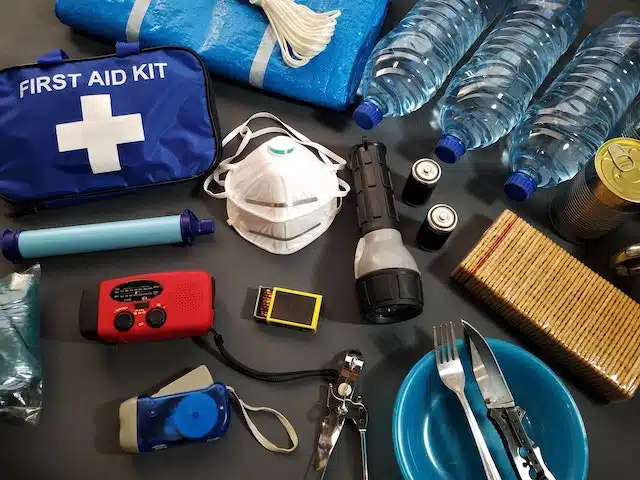
Does car insurance cover if you’ve hit an animal?
For anyone who’s ever hit an animal while driving you’ll know it can be a distressing experience. Planning for ‘just in case’, being road aware and taking extra care at dawn and dusk helps reduce the likelihood.
Most comprehensive car insurance policies will cover you when you hit an animal. However, different insurers treat this situation differently when it comes to excess. Some will still charge you the excess to repair your car while others won’t. (If you hit livestock then you’ll need to claim on your own insurance but check the relevant rules for your area).
Pet insurance for animal related car accidents
It’s also important to be prepared in case your own animal is hit by a car in future. Pet insurance will cover a range of medical costs that may arise when your furry, feathered, hairy or scaly friend has a bingle.
PD Insurance recognises the importance of covering your pet for this situation. Why not get a cat insurance or dog insurance quote with us and discover how to safeguard your pet’s life? If you buy their plan online you’ll get one or more months of FREE pet insurance.
Click below to start a pet or car insurance quote today.
Share On:

